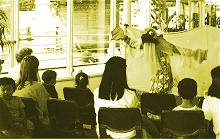|
‘Looking after our Bay’ - Information brochure
What
A simple information flyer (tri folded A4 size) produced by the Kurnell Public School with the assistance of the Botany Bay Field Studies Centre. The brochure provided useful information for the local community on ways to help protect the local marine environment.
|
Where Botany Bay.
How |

Performance at Sydney Maritime Musuem
- Seaweek 99 |
| During the year, Grade 5 at Kurnell Public School undertook a marine studies unit which involved working with the Botany Bay Field Studies Centre to learn about their local marine environment. |
As part of that unit the class produced a brochure which gave information about the local marine environment and some ideas of ways in which to help protect the waterways. The students researched relevant material and then wrote the brochure, including the headings of Boating, Birds, Shells, Fishing, Protected Areas, Sensitive Habitats, Pollution Solutions and Taking Care of Yourself. It was edited by the Botany Bay Field Studies Centre.
The brochures were launched during Seaweek at Lilli Pilli School and followed by a performance from the 'Resyche's' Environmental Theatre group. Brochures were sent home to all parents via the school newsletters. For wider community distribution they were also placed in local shops etc.
Why
The Grade 5 students decided that they would like to have clean beaches, clean water and the chance to see and enjoy a wide variety of marine life in their local area. They knew it would take a big effort by everyone if they were to achieve this. They hoped that with further information and understanding of the local marine environment, the community would be more interested and inspired to take actions towards caring for it. They saw that one way of providing this local information was by producing and distributing a brochure.
Events held in 1999 ..
|